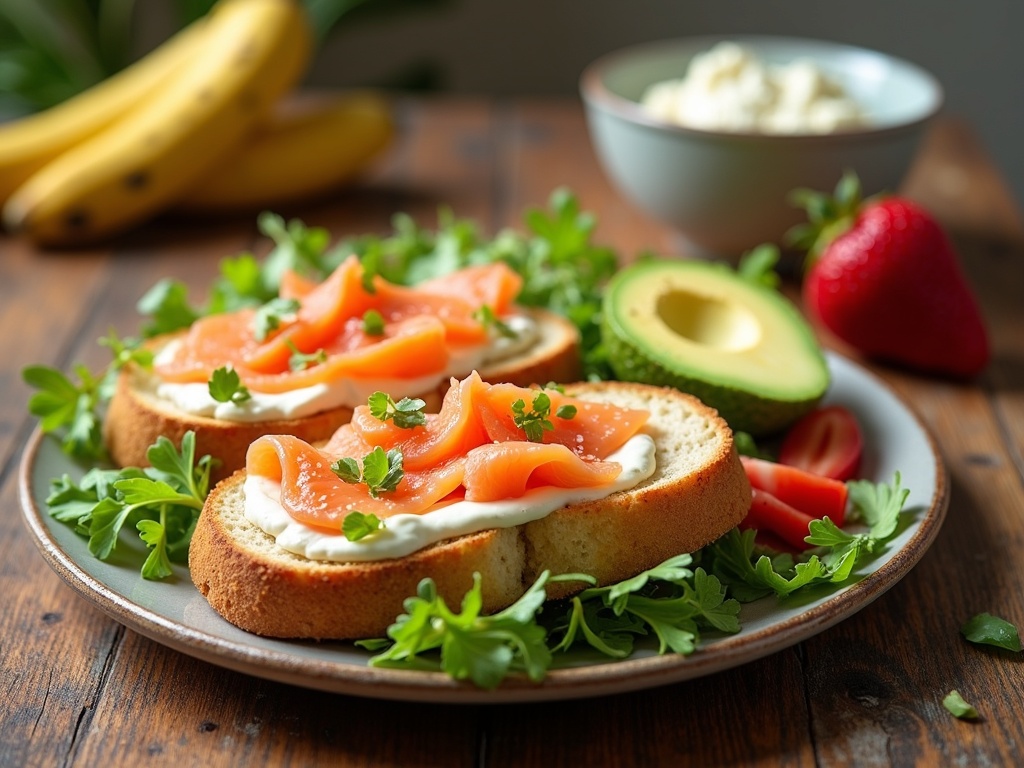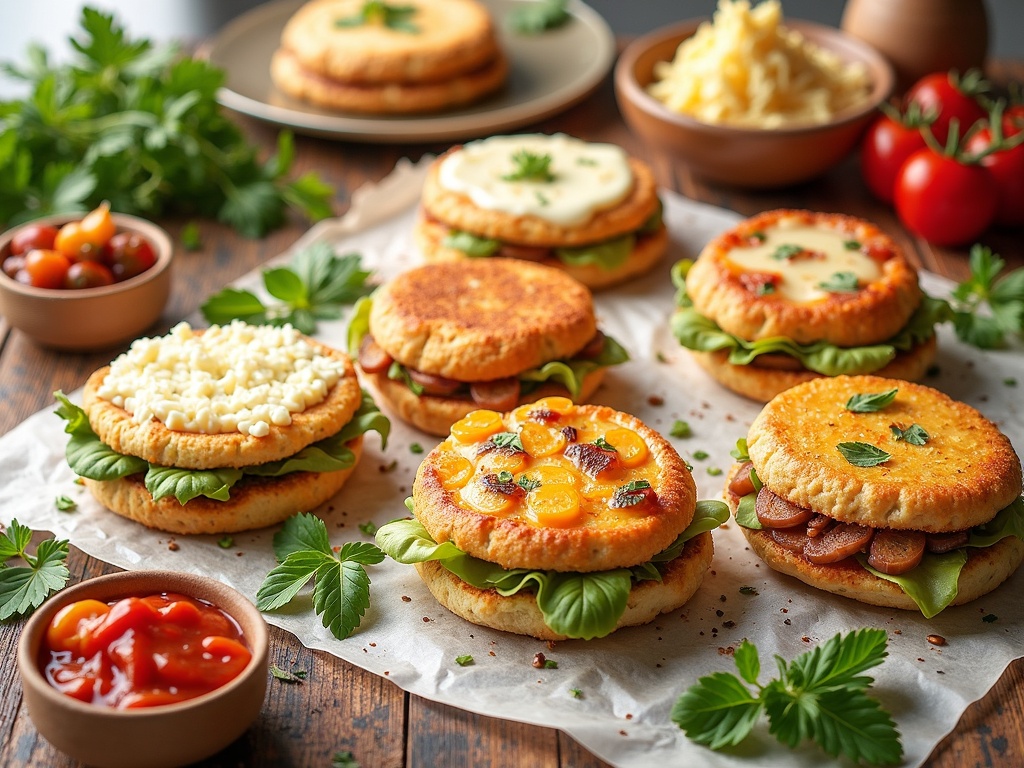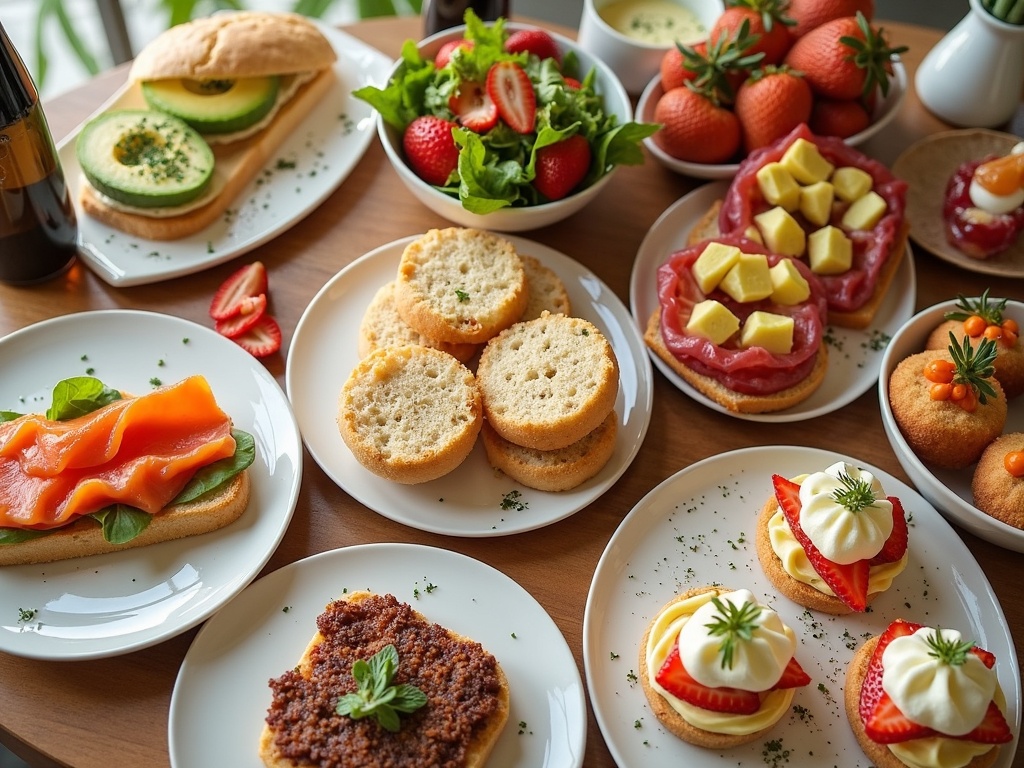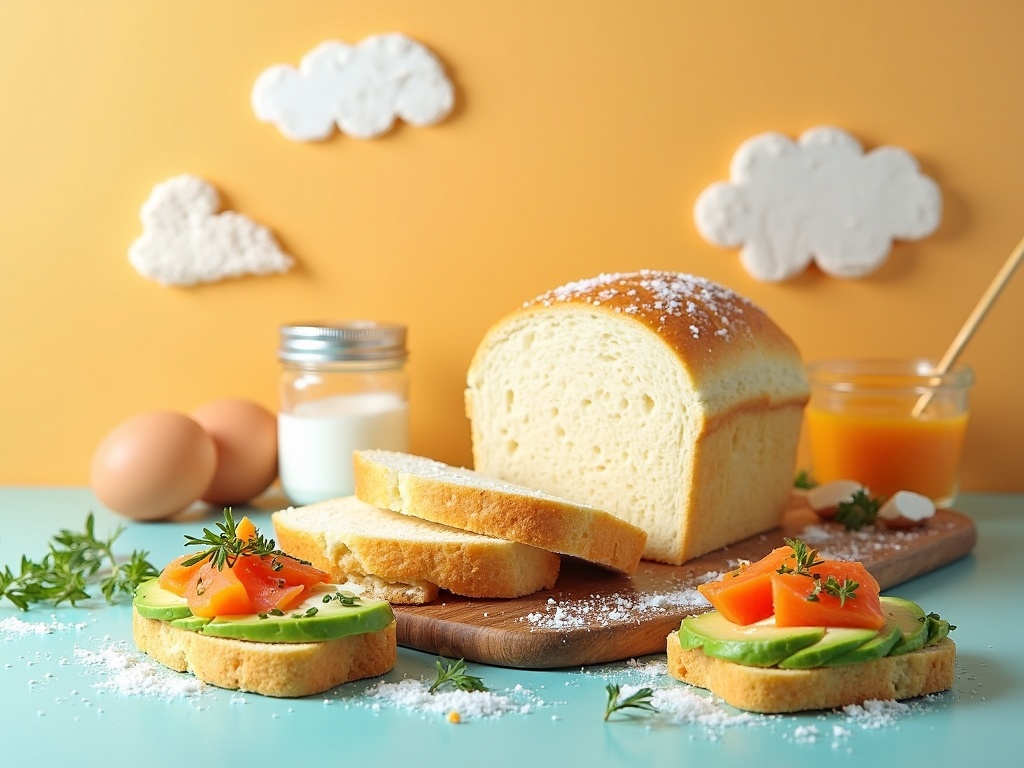Cloud Bread 2.0 has taken social media by storm, captivating millions with its fluffy texture and vibrant colors. This eye-catching, gluten-free alternative strikes a perfect balance between visual appeal and practical benefits, making it accessible for kitchen beginners while satisfying health-conscious eaters.
Find In This Article
Key Takeaways
- Cloud Bread 2.0 is part of the booming gluten-free food market, which reached $22.35 billion in 2020 and is projected to grow at 9.8% annually through 2028.
- The recipe requires minimal, accessible ingredients and offers impressive nutritional benefits with just 140 calories per serving, 12g of healthy fats, 9g of protein, and less than 1g of carbohydrates.
- Proper whisking technique and gentle folding are crucial for achieving the signature light, airy texture that defines successful Cloud Bread.
- The neutral base makes Cloud Bread highly customizable with both savory and sweet flavor additions, from herbs and cheese to vanilla and cinnamon.
- Cloud Bread 2.0’s versatility extends beyond basic bread applications to sandwiches, appetizers, and even desserts, making it suitable for various dietary needs including keto, gluten-free, and low-carb.
I’ve found this trendy creation sits perfectly at the crossroads of current dietary preferences and social media shareability. Its simple yet impressive nature has helped it gain traction among those looking for bread alternatives that don’t sacrifice texture or taste.
Why Cloud Bread 2.0 is Taking Over Social Media
Cloud Bread 2.0 has catapulted into viral fame, with preparation videos racking up millions of views across TikTok and other social platforms. This fluffy, colorful treat isn’t just visually appealing—it’s part of a larger movement toward gluten-free alternatives that’s reshaping how we think about baking.
The Viral Sensation Behind the Trend
I’ve watched countless Cloud Bread videos pop up on my feed, each one more mesmerizing than the last. The appeal is clear: these puffy, cloud-like creations can be customized with vibrant colors and flavors, making them perfect for social sharing. What makes them especially intriguing is how they transform from simple ingredients into towering, airy confections right before your eyes.
The colorful, Instagram-worthy nature of Cloud Bread 2.0 makes it irresistible to content creators looking for engaging food content. Its simplicity appeals to novice bakers, while the dramatic reveal when pulling apart the finished bread creates that perfect “wow” moment that drives shares and likes.
Part of a Bigger Gluten-Free Movement
This trend isn’t happening in isolation—Cloud Bread 2.0 sits firmly within the booming global gluten-free food market, which reached an impressive $22.35 billion in 2020. The market shows no signs of slowing down, with projections indicating a strong 9.8% compound annual growth rate from 2021 through 2028.
The numbers tell an important story about changing dietary preferences:
- Approximately 30% of Americans are actively seeking gluten-free options
- Cloud Bread offers a simple, accessible entry point to gluten-free baking
- The viral nature of the recipe has introduced gluten-free options to audiences who might not have considered them before
What makes gluten-free bread alternatives like Cloud Bread 2.0 particularly appealing is their accessibility. Unlike many specialized baking recipes, Cloud Bread requires just a few ingredients that most people either have on hand or can easily obtain.
The timing couldn’t be better for this trend, as more people experiment with homemade recipes and alternative diets. Cloud Bread 2.0 sits at the perfect intersection of visual appeal, dietary flexibility, and simple preparation—making it not just a passing fad, but potentially a lasting addition to the repertoire of home bakers looking for something different to try.
What Makes This Bread Different
Cloud Bread 2.0 is truly a game-changer in the world of bread alternatives. I’ve found it to be one of the most innovative solutions for those wanting to enjoy bread-like textures without the traditional ingredients. This fluffy, airy creation stands apart from conventional bread in several important ways.
Nutritional Profile and Ingredients
Cloud Bread 2.0 offers a completely gluten-free experience while maintaining an impressively low carbohydrate count. Instead of wheat flour, it relies on a simple combination of eggs, cream cheese, and baking powder as its primary ingredients. This clever substitution creates a bread-like consistency without the gluten or carbs that many people try to avoid.
The nutritional breakdown is what makes this bread truly stand out:
- Just 140 calories per serving (2 slices)
- 12g of healthy fats
- 9g of protein
- Less than 1g of carbohydrates
- Rich in essential vitamins A, D, E, and B12
Compare this to traditional bread, which typically contains around 140 calories per serving but derives most of its energy from carbohydrates. Regular bread often lacks significant protein content and contains minimal beneficial fats.
The egg base provides exceptional protein content, making Cloud Bread a perfect option for sandwiches where you want added nutrition. The cream cheese delivers a pleasant tanginess while contributing to the bread’s moist texture.
For those following specific dietary approaches like keto, paleo, or low-carb plans, Cloud Bread 2.0 fits perfectly into meal planning. Its minimal carbohydrate content makes it suitable for blood sugar management concerns, while the absence of gluten addresses needs for those with celiac disease or gluten sensitivity.
The vitamin content is another significant advantage. Thanks to the egg content, Cloud Bread 2.0 delivers important fat-soluble vitamins (A, D, and E) along with B12 – nutrients often missing in typical gluten-free products. These vitamins support everything from immune function to energy metabolism.
I’ve found Cloud Bread 2.0 to be incredibly versatile in the kitchen. It can be used for lighter alternatives to fried bread dishes or as a base for open-faced sandwiches. The neutral flavor profile allows it to pair well with both sweet and savory toppings.
Unlike many other gluten-free alternatives that try to mimic traditional bread with complicated flour blends, Cloud Bread 2.0 takes a completely different approach. Rather than attempting to recreate wheat bread exactly, it offers a unique eating experience that stands on its own merits – light, airy, and satisfying in a completely different way from conventional bread.
The simplicity of ingredients also means fewer additives and preservatives than many commercial gluten-free products, which often rely on stabilizers and texturizers to approximate traditional bread. Cloud Bread 2.0 delivers a clean eating experience with recognizable, whole-food ingredients.
For anyone exploring bread alternatives for classic recipes, Cloud Bread 2.0 represents a brilliant innovation that doesn’t feel like a compromise. Its unique properties make it suitable for everything from breakfast toast to lunch sandwiches, proving that dietary restrictions don’t have to mean giving up the foods you love.

Creating the Perfect Cloud Bread
The secret to exceptional cloud bread lies in mastering a few key techniques. I’ve found that paying special attention to the egg whites makes all the difference in achieving that signature fluffy texture.
Perfecting the Whisking Technique
Creating stiff egg white peaks requires patience and proper technique. I start with room temperature eggs as they whip more effectively than cold ones. Using a completely clean and dry mixing bowl is crucial—any trace of grease will prevent proper stiffening. I begin whisking at medium speed, gradually increasing to high once the whites become foamy. The egg whites are ready when they form stiff, glossy peaks that stand straight up when the beater is lifted.
After perfecting the egg whites, I gently fold in a mixture of egg yolks, cream cheese, and baking powder. The key word here is “gently”—using a folding motion rather than stirring helps maintain the air bubbles that give cloud bread its characteristic lightness.
For consistent results, I use a digital kitchen scale for precise measurements. This precision makes a significant difference in the final texture. The batter should be thick but still airy when properly combined.
The baking process is equally important. I’ve found that 25-30 minutes at 300°F (150°C) produces the best results. The low temperature allows the bread to rise slowly and set properly without browning too quickly. The bread is done when it’s golden on top and feels firm to the touch.
Here are my top tips for achieving the perfect consistency:
- Line your baking sheet with parchment paper rather than greasing it
- Space the bread portions at least 2 inches apart to allow for expansion
- Cool completely on a wire rack before serving to prevent collapse
- Store in an airtight container with parchment paper between layers
- Let the bread rest for a few hours after baking for improved texture
When properly prepared, cloud bread should have a light, airy texture similar to a meringue, but with enough structure to hold together as a bread substitute. The exterior should be slightly crisp while the interior remains soft and pillowy.
If your first attempt isn’t perfect, don’t get discouraged. Like any specialized bread recipe, cloud bread takes practice to master. Small adjustments to your technique with each batch will help you find the perfect method for your kitchen conditions.
Customizing Your Cloud Bread
Cloud Bread 2.0 offers incredible versatility when it comes to flavor customization. I’ve found that the neutral base makes it perfect for adding various seasonings and ingredients to match whatever meal I’m preparing. Unlike traditional bread recipes that often limit your flavor options, Cloud Bread serves as a blank canvas for culinary creativity while keeping carbs low.
Savory Flavor Combinations
The basic cloud bread recipe accepts savory additions beautifully. I’ve experimented with several popular mix-ins that transform the basic recipe into something extraordinary:
- Rosemary cloud bread: Adding 1-2 teaspoons of fresh chopped rosemary to the batter creates a fragrant bread perfect for pairing with roasted chicken or lamb.
- Garlic powder variation: Just 1/2 teaspoon mixed into the batter enhances almost any sandwich creation.
- Onion powder infusion: A subtle 1/2 teaspoon adds depth without overpowering the delicate texture.
- Cheese-enhanced version: Folding in 2-3 tablespoons of grated parmesan, cheddar, or mozzarella creates a richer, more substantial bread.
What makes these additions special is how they maintain the bread’s low-carb integrity while significantly boosting flavor. I’ve served the garlic and cheese variation to friends who couldn’t believe they were eating something keto-friendly.
For more substantial meal options, I often make cheese sandwich variations using cloud bread as the base. The lighter texture creates a different experience than traditional sandwiches but satisfies the same cravings.
Themed Flavor Profiles
Taking customization further, I’ve created entire themed variations that transform cloud bread into meal-specific companions:
Mexican-inspired cloud bread works brilliantly with taco seasonings (about 1 teaspoon per batch). I add a pinch of cumin, chili powder, and garlic for bread that complements fajitas or serves as a soft taco alternative. This variation pairs perfectly with avocado, seasoned meat, and fresh salsa.
Italian herb cloud bread makes an exceptional base for mini pizzas and sliders. I mix in dried basil, oregano, and a touch of thyme to create toad in the hole recipe alternatives that satisfy pizza cravings without the carbs. Simply bake the cloud bread, add sauce, cheese and toppings, then broil briefly until bubbling.
Sweet cloud bread variations are possible too. A touch of vanilla extract and cinnamon transforms the recipe into something reminiscent of bread and butter pudding when layered with custard and baked.
For breakfast options, I’ve created a version that mimics fried bread by adding a pinch of baking powder to the original recipe and pan-frying the finished bread in a small amount of butter until golden.
The beauty of cloud bread customization lies in its ability to maintain dietary compliance while providing tremendous flavor variety. Whether following keto, gluten-free, or low-carb eating plans, these adaptations keep meals interesting without compromising nutritional goals.
Cloud bread’s neutral base also accepts spices from various culinary traditions. I’ve created successful variations inspired by butter naan by adding a touch of yogurt to the base recipe along with cumin, coriander and minced garlic.
By thinking of cloud bread as a foundation rather than a finished product, I’ve created dozens of variations that keep my meal planning fresh and exciting. The customization options far exceed what’s possible with traditional bread recipes, making Cloud Bread 2.0 an essential part of creative, health-conscious cooking.

Beyond Basic Bread: Versatility and Uses
Cloud Bread 2.0 has completely changed my approach to everyday meals with its incredible versatility. Unlike traditional bread, this fluffy alternative serves multiple culinary purposes without the carb overload. I’ve discovered it works perfectly as a sandwich base for lunch, a dessert foundation for sweet treats, and even as an appetizer canvas for elegant party presentations.
Culinary Applications and Meal Integration
The adaptability of Cloud Bread 2.0 makes it ideal for nearly any meal scenario. For breakfast, I top it with avocado and eggs for a nutritious start to the day. At lunch, it transforms into sandwich bread that doesn’t leave me feeling sluggish in the afternoon. For dinner gatherings, small cloud bread rounds become the perfect base for passed appetizers that even my pickiest guests enjoy.
What makes this bread alternative truly special is how it fits into modern lifestyle needs. The health food market has seen remarkable growth, valued at $715 billion globally in 2021, with projections to reach $1 trillion by 2027. Cloud Bread 2.0 sits squarely within this expanding category as consumers increasingly seek nutritious alternatives to traditional staples.
I’ve found it particularly helpful for meal prep since it freezes beautifully and reheats in minutes. On Sunday afternoons, I make a large batch, freeze individual portions, and have bread ready throughout the week without daily preparation. This time-saving approach has been a game-changer for maintaining healthy eating habits despite my busy schedule.
The dietary accommodation factor can’t be overlooked. Cloud Bread 2.0 addresses multiple dietary restrictions simultaneously:
- Gluten-free eaters can enjoy a bread-like experience without wheat concerns
- Keto followers appreciate its low-carb profile that maintains ketosis
- Those watching calories benefit from its lighter nutritional profile
- People with diabetes can enjoy bread again with minimal blood sugar impact
- High-protein dieters get added protein that traditional bread lacks
I’ve served it at gatherings where guests follow different dietary approaches, and everyone could participate in the meal without feeling excluded. This inclusivity factor makes Cloud Bread 2.0 particularly valuable in today’s diverse dietary landscape.
For dessert applications, I’ve used it as a base for strawberry shortcake, created bread pudding variations, and even made a tiramisu-inspired layered dessert. The neutral flavor profile allows it to adapt to both sweet and savory applications without competing with other ingredients.
When entertaining, small rounds topped with cream cheese and smoked salmon have become my signature appetizer. I’ve also created miniature pizza bases and bite-sized cheese sandwich variations that disappear quickly at parties.
What truly sets Cloud Bread 2.0 apart is how it bridges the gap between health-conscious eating and culinary enjoyment. Rather than feeling like a compromise, it offers genuine culinary possibilities that stand on their own merits. The texture has improved significantly over earlier cloud bread versions, with a more authentic mouthfeel that satisfies bread cravings.
For families with mixed dietary needs, it eliminates the need to prepare multiple versions of meals. I simply make a single batch of Cloud Bread that works for everyone, saving time and simplifying meal planning.
As health-conscious eating continues gaining momentum, Cloud Bread 2.0 represents the type of food innovation driving market growth. It offers genuine functional benefits while maintaining the enjoyment factor that keeps people coming back for more.

Sources:
Grand View Research – Gluten-Free Products Market
Healthline – Cloud Bread
Market Research Future – Healthy Food Market
Pew Research – Social Media Food Trends

